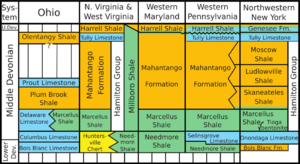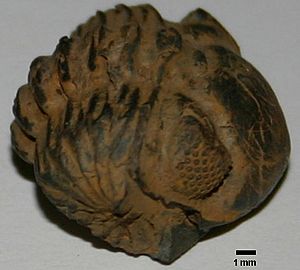Mahantango Formation facts for kids
Quick facts for kids Mahantango FormationStratigraphic range: Givetian, ~387Ma |
|
|---|---|

Outcrop of the Mahantango on Rt. 522, Fulton County, Pennsylvania
|
|
| Type | Geological formation |
| Unit of | Hamilton Group |
| Sub-units | See: Description |
| Underlies | Harrell Shale and West Falls Formation |
| Overlies | Marcellus Formation |
| Lithology | |
| Primary | Shale |
| Other | Limestone, Siltstone |
| Location | |
| Region | Appalachian Basin of eastern North America |
| Extent | Maryland, New Jersey, New York, Ohio, Pennsylvania, Virginia, and West Virginia |
| Type section | |
| Named for | Mahantango Creek |
The Mahantango Formation is a special type of rock layer found in Pennsylvania, West Virginia, and Maryland. It formed a very long time ago, during the Devonian Period. This rock layer gets its name from the North branch of the Mahantango Creek in Pennsylvania. It's part of a bigger group of rocks called the Hamilton Group. Below it, you'll find another rock layer called the Marcellus Formation. In some parts of Pennsylvania, the lower sections of the Mahantango Formation are also known as the Montebello Formation.
Contents
What is the Mahantango Formation Made Of?
The Mahantango Formation is mostly made of gray, brown, and olive-colored siltstone and shale. These rocks often show "coarsening-upward cycles." This means the rock layers start with finer grains at the bottom and get coarser (bigger grains) as you go up.
Where is the Mahantango Formation Found?

The Mahantango Formation usually sits right on top of the Marcellus Formation. Above it, you might find a rock layer called the Tully Limestone.
The Mahantango Formation can be split into four main parts, called "members":
- Tully Limestone: This part is a shale that contains many fossils. It helps separate the Mahantango from the Hamilton Group.
- Sherman Ridge: This section has olive-gray claystone and siltstone. It also has layers of fine sandstone that get coarser as you go up. Many fossils are found here.
- Montebello Sandstone: This part is made of olive-gray sandstone with coarse to fine grains. It's mixed with siltstone and claystone and also shows coarsening-upward cycles. Fossils are common.
- Fisher Ridge: This section includes silty claystone, siltstone, and very fine-grained sandstone. It's sometimes called the Dalmatia or Turkey Ridge.
The Sherman Ridge and Fisher Ridge parts often form ridges in the landscape. In south-central Pennsylvania, the Mahantango also includes other sections like the Clearville, Frame, Chaneysville, and Gander Run Members.
Amazing Fossils Found in the Mahantango Formation

The Mahantango Formation is famous for its many marine (ocean) fossils. These fossils tell us about the ancient sea life that lived there millions of years ago. You can find:
- Brachiopods
- Crinoids (also known as "sea lilies")
- Trilobites
- Bivalves (like clams)
- Bryozoans (tiny colonial animals)
- Corals
- Gastropods (snails)
- Cephalopods (like ancient squid)
Brachiopods
- Athyris
- Chonetes
- Mucrospirifer
- Protoleptostrophia
- Tropidoleptus
Trilobites
- Basidechenella
- Dipleura
- Eldredgeops (used to be called Phacops)
- Greenops
Bivalves
- Grammysioidea
- Grammysia
- Leiopteria
- Modiomorpha
- Orthonota
Corals
- Pleurodictyum
- Trachypora
Gastropods
- Bembexia
- Crenistriella
- Cyclonema
- Glyptotomaria
- Loxonema
- Platyceras
Cephalopods
- Tornoceras
- Agoniatites
- Spyroceras
- Michelinoceras
- Bactrites
How Old is the Mahantango Formation?
Scientists use special methods to figure out the age of rock layers. The Mahantango Formation formed during the Middle Devonian period. This was about 392 to 385 million years ago! It sits directly on top of the Marcellus Formation shale. Above it, you'll find the Trimmers Rock Formation and Harrell Shale. In 2012, scientists Read and Erikson confirmed that the formation in Virginia belongs to a specific time within the Devonian called the Givetian Stage.
Images for kids



